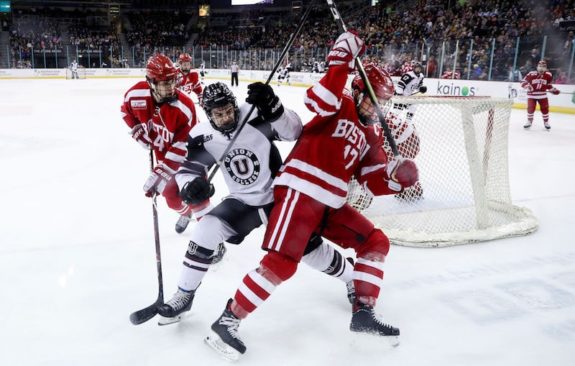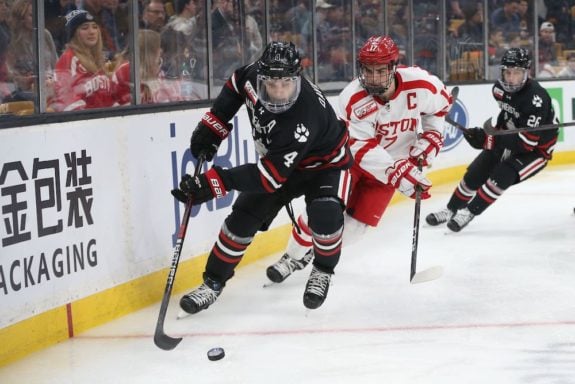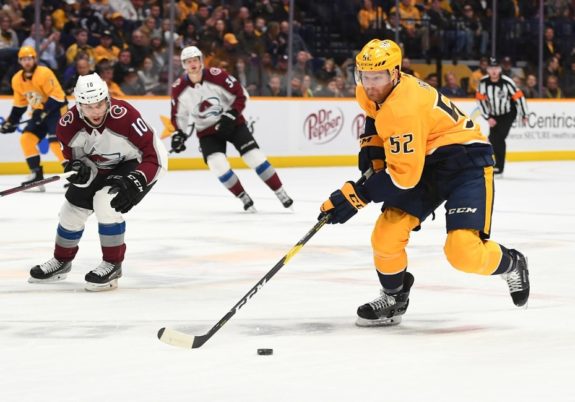On Monday, March 25, Sportsnet’s Chris Johnston reported that the Nashville Predators have signed prospect Dante Fabbro to an entry-level contract (ELC). This is great news for the team and its fans as Fabbro, Nashville’s top defense prospect, decided to forego his senior season with Boston University and turn pro. It means any risk of losing him to free agency after the 2019-20 season has gone away.
Who is Dante Fabbro?
The Predators drafted Fabbro 17th overall in the 2016 Entry Draft out of the British Columbia Hockey League’s (BCHL) Penticton Vees, where he was teammates with current Colorado Avalanche player Tyson Jost. In 2015-16, his draft season, Fabbro scored 14 goals and 67 points in 45 games. He finished third on the team in points but scored 27 more than any other Vees defenseman. He also led the BCHL in points by a blueliner, with a four-point lead. He was named the league’s top defenseman at season’s end.
Related: Predators Prospect Report – Fabbro & Farrance
Fabbro was already committed to Boston University and joined them for his freshman season in 2016-17. In 36 games, he had six goals and 18 points, second among Terriers defensemen after Charlie McAvoy. As a sophomore in 2017-18, he had nine goals and 29 points, fifth on the team, but first at the position. Finally, this season he posted seven goals and 33 points in 38 games. He finished second on the team in points and led B.U. blueliners by 13. He was named to the Hockey East Conference’s second All-Star Team in both 2016-17 and 2017-18.

Internationally, he has represented Canada a number of times. He played on the nation’s U18 team in 2016 when he had eight assists in seven games. The following two years he was on Canada’s World Junior teams, earning silver in 2017 and gold in 2018. He finished with one assist in 14 games across the two tournaments. He also represented Canada at the 2018 Spengler Cup, where he finished with two goals and an assist in four games. His three points tied for second on the team. Despite being significantly younger than most of the competition, Fabbro thrived.
What Are His Skills?
Now onto what makes Fabbro such a highly-touted prospect. He has been a well-known defenseman for quite some time, and as far back as the 2016 pre-draft scouting reports, he was declared NHL-ready before playing in college, a major junior league or the American Hockey League. Scouting reports and the eye test reveal that he is a steady, right-shot, puck-moving defenseman, one of the most valuable commodities in today’s NHL.
But perhaps the best aspect of his game is that he is quiet; he doesn’t make high-risk, high-reward plays, offensively or defensively. He plays in all situations, and on a bad B.U. team in 2018-19, he received the team’s toughest assignments, and succeeded. Let’s look at some of Fabbro’s individual skills.

Fabbro is at his best when transitioning the puck. He has the vision, intellect, skating and passing abilities to move the puck from the defensive zone and into the offensive zone. When in the defensive zone, he almost always makes the right read to clear the zone – whether it’s by hitting the forward on the breakout, using the boards/glass to relieve pressure or skating the puck out himself. He’ll also turn back behind the net to create space and time for himself and teammates. He’s unafraid to lead the rush himself, either by carrying the puck or skating through the neutral zone and receiving the breakout pass.
When in the offensive zone, Fabbro knows what to do. He is a pass-first defenseman who, once again, uses his vision to find the open man to create scoring chances. However, his shot is still accurate and hard enough that opponents respect it. This is most evident on the power play, where he’ll often fake a shot to draw penalty killers into his shooting lane, only to pass it to an open teammate. If there’s one knock to his offensive game, it’s that he doesn’t shoot the puck enough. As a freshman, he averaged 2.08 shots-per-game. As a junior, he averaged 2.84, and increased his shot rate each season, which is a good thing.
If he begins to shoot more, it will make him more of an offensive threat, especially when combined with his other skills, including his knowledge of where to go in the offensive zone. The clip below, from this season, highlights this combination.
Against Union College and on the power play, the Terriers are in the offensive zone with Fabbro at the point. The puck comes to him and he works it to the faceoff circle, after which he switches sides at the blue line. He gets the puck back and threads a cross-ice pass to the opposite faceoff dot. He then works himself down low and waits for a cross-ice pass to arrive, which he one-times for a goal. In one play, you see everything he brings offensively.
Defensively, Fabbro is also very skilled. With his 6-feet, 190-pound frame, he isn’t the biggest or most imposing defender. That being said, he isn’t afraid to step up on opponents entering the offensive zone. But because he isn’t the most physical blueliner, he relies on strong positioning, good stick work and skating to defend. He’s also unafraid to get in shooting lanes and block shots.
A couple of examples come to mind when Fabbro exhibited these elements. At the 2016 U18 Tournament, Sweden’s Lias Andersson (2017 seventh-overall pick) entered the offensive zone and Fabbro pressured him against the boards. Andersson spun away from the check and handed the puck off to a teammate. Recognizing this, Fabbro stayed with the new puck-carrier and pressured him, which forced a turnover that a Team Canada player gathered, leading to a zone exit.
Another example was at the 2018 Spengler Cup. Against KalPa (of Finland’s Liiga), Columbus Blue Jackets’ 2017 second-round pick Alexandre Texier took the lead pass on a breakaway. In a recovery attempt, Fabbro caught up and gained inside position on Texier and stick-lifted him, impeding a scoring chances while not taking a penalty. It was the perfect defense against a Grade-A scoring chance.
So, to recap, Fabbro is a great two-way defenseman who thrives in every situation. He’s positionally sound and uses his skating to his advantage while defending, yet is still skilled enough to be a scoring threat in the offensive zone. He can quarterback a power play but also blocks shots on the penalty kill. He’s at his best when transitioning the puck and is the epitome of what is desired in a modern defenseman.
What Is Expected of Him?
While details have yet to emerge surrounding his contract, it’s believed to be a three-year deal, the first year of which will expire when he plays his first game in either the AHL or NHL. Given his talent level and playing style, it’s likely he plays in the NHL this season, on the bottom pair. In Dan Hamhuis’ absence, he could play the right side, opposite of Matt Irwin, and could replace Irwin when Hamhuis returns. Fabbro is a better skater than Irwin and more adept at clearing the defensive zone.
There will certainly be a learning curve, but Fabbro’s game should transition well to the NHL. Although the league is faster than the college game, it could bode well for him. Throw in the fact that he’d play insulated minutes on the third pair and could even earn some power-play time, and it seems like a no-brainer to play him, especially if head coach Peter Laviolette wants to ice the most talented team on a nightly basis. Fabbro is already better than Irwin, Yannick Weber or Matt Donovan.

Looking to the future presents an interesting situation. Fabbro is talented enough to immediately be a top-six defenseman. However, he has the potential to be a top-four blueliner and could likely develop into a top pair guy. But, when you look at Nashville’s defense depth, their top-four is already one of the best and Fabbro isn’t supplanting any of them, which means one of their current top-four defensemen could be dealt.
All four are signed through 2019-20, and Roman Josi is the first one up when his contract expires after next season. That could make him a candidate to be traded given that he’ll be due a hefty raise, but he’s a left shot, which would give the team an uneven shot balance. Meanwhile, Ryan Ellis recently signed an extension that starts next season and Mattias Ekholm is on a team-friendly contract through 2021-22.
That leaves P.K. Subban. He’s a right-shot defenseman whose contract expires after 2021-22 but carries a $9 million cap hit. It almost makes too much sense to eventually trade him for a top-six forward and slot Fabbro in his spot on a pair with Ekholm. Losing him would hurt, but it may be necessary.
But for now, it’s all exciting news. Fabbro was one of college hockey’s best defensemen and he plays a game similar to that of the Predators’ current blueliners. That means his transition to the NHL should be fairly smooth. All of a sudden, arguably the league’s best blue line just got better.
*All stats courtesy of Elite Prospects